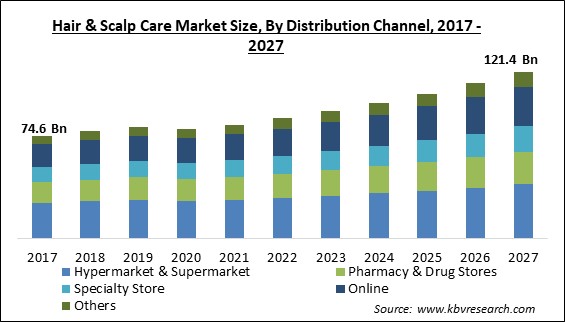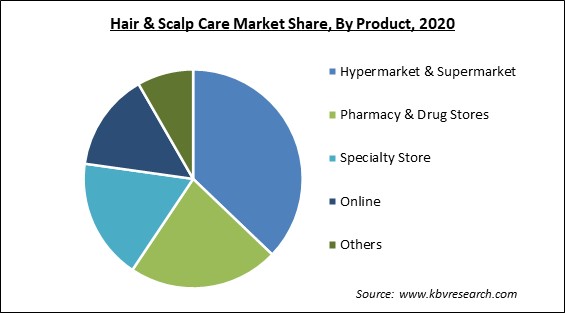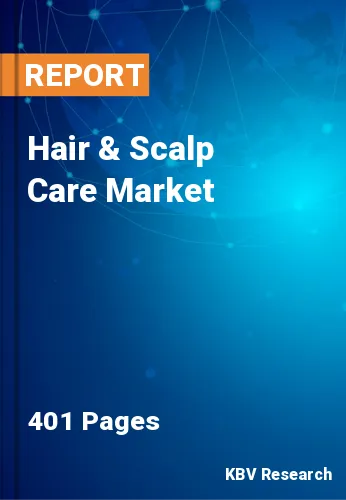The Global Hair & Scalp Care Market size is expected to reach $121.4 billion by 2027, rising at a market growth of 6.5% CAGR during the forecast period.
Haircare products assist men and women in maintaining the health and cleanliness of their hair while also protecting it from injury. Shampoo, serum, conditioner, oil, serum, and other hair-nourishing treatments come in a range of liquid, gel, cream, and lotion forms. Based on the type of hair, there is a range of products available on the market for various applications. Shampoos for dry and greasy hair, conditioners for damaged scalp and hair healing, and shampoos for colored and curly hair are all available.
Haircare products are utilized in salons by hairstylists and by individuals at home. Shampoo, conditioner, hair styling gels, colorants, serums, glazes, hair spray, hair growth products, and hair accessories are among the several types of hair care products available on the market, depending on the type of hair and its needs. Issues like split ends, rough, weak, dull, and dehydrated hair can all be treated with modern hair care solutions.
Haircare entails using a variety of products to clean, protect, and enhance the texture and appearance of one's hair. Gels, oils, tonics, rinses, masks, serums, shampoos, conditioners, dressings, and sprays are examples of these products. In addition, to stay up with the ever-changing hair trends, various companies are currently producing fresh and revolutionary silicone and sulfate-free products. Moreover, rising disposable incomes, growing living standards, and the increasing adoption of modern grooming methods are expected to act as the growth catalysts for the hair & scalp care market during the forecasting period.
Several companies are offering customized products to meet specialized consumer needs, which range from cleansing, styling, softening, and strengthening to scalp care, thermal protection, damage repair, frizz control, color retention, moisturization, and bond-building, due to the diversity and complexity of hair types and concerns. Additionally, rising awareness of hair-related difficulties as a result of climate change, air pollution, and other environmental conditions, is one of the key trends of the industry.

The COVID-19 pandemic has had an impact on the hair & scalp care market, since there have been extensive retail and salon shop closures, resulting in lower global sales of numerous beauty and personal care products. Because of the pandemic, for example, Beiersdorf AG reported a 1.9 percent drop in sales across the board in the second quarter of 2020. Because of the aforementioned reason for salon closures, consumers in the worldwide marketplace have adopted one of the most noticeable trends: do-it-yourself (DIY) beauty care. Because of concerns about direct physical contact, many beauty salons have closed, and even in regions where they haven't, consumers have avoided these services. As a result, DIY hair coloring is gaining popularity. As a result, haircare sales in Superdrug stores in the United Kingdom climbed by 76 percent year to date (April-May 2020), including root touch-up goods such as hair color.
The strong demand for natural ingredients has led to the majority of companies developing products with nature-inspired components, like plant-inspired and premium botanical ingredients. In addition, conditioners and shampoos, serums and oils, and styling are among the organic hair care product types that are highly popular among both genders around the world owing to their widespread use. Moreover, anti-dandruff organic hair oils are also predicted to increase strongly during the forecast period. Organic hair care products are projected to see a significant surge in demand in Western Europe. The growing popularity of colored hair among young people is likely to drive up demand for dyes and colors, particularly among women. For example, according to data given by Breast Cancer.
Hair concerns such as greying, dandruff, and hair loss are becoming more common among men, which is likely to increase the use of hair care products. For example, according to data published in the Journal of Clinical and Diagnostic Research in October 2018, 60.3 percent of males aged 18-50 suffer from hair loss, while 17.1 percent suffer from dandruff. In addition, because the elderly is more susceptible to hair problems than the younger age, demand for such products would further increase in the upcoming years. According to the United Nations Department of Economic and Social Affairs, the global population of people aged 65 and up reached 703 million in 2019. As people become more aware of the negative impacts of chemicals on their health and the environment, their preferences are turning toward organic and herbal products. Aveda Corp.'s hair care products
Haircare products are in high demand all around the world. Moreover, businesses are committed to meeting the needs of their customers. However, this rising demand is contributing to an increase in the number of counterfeit products that contain dangerous substances. In addition, hair cleaners containing dangerous ingredients that claim to have desired benefits and are inexpensive have had a variety of harmful effects on the scalp and hair growth. Additionally, DIY (Do-It-Yourself) product kits and a greater understanding of home therapies for hair cleaning, such as the use of amla (Indian gooseberry), reetha (Indian soapberry), egg yolk, and curd, are viable alternatives to haircare products.

Based on Product, the market is segmented into Anti-dandruff (Hair Shampoo and Hair Conditioner & Others), Hair Loss (Hair Shampoo, Hair Conditioner, Hair Oil and Others), Dry & Dull Hair (Hair Shampoo & Conditioner, Hair Oil, and Others), Dry & Itchy Scalp (Hair Shampoo & Conditioner and Hair Oil), White & Grey Hair (Hair Shampoo & Conditioner and Hair Oil & Others) and others. The Hair Loss segment collected a significant revenue share of the Hair & Scalp Care Market in 2020. Hair loss is caused by a variety of factors, including hormonal changes, medical disorders, hereditary, and aging. In addition, hair loss has become more common in men than in women in recent years, resulting in increased product demand.
Based on Distribution Channel, the market is segmented into Government, Hypermarket & Supermarket, Pharmacy & Drug Stores, Specialty Store, Online and Others. The Online segment held a significant revenue share of the Hair & Scalp Care Market in 2020. This is because of a bigger distribution network and higher product availability. Moreover, many customers are attracted to online channels to buy haircare products because they are easy to use, the option to compare different products from different companies, appealing discounts, and other benefits. In addition, consumers are increasingly turning to these stores for personal care items for their hair, particularly those who are certain of the brand or type of goods they want.
| Report Attribute | Details |
|---|---|
| Market size value in 2020 | USD 80.1 Billion |
| Market size forecast in 2027 | USD 121.4 Billion |
| Base Year | 2020 |
| Historical Period | 2017 to 2019 |
| Forecast Period | 2021 to 2027 |
| Revenue Growth Rate | CAGR of 6.5% from 2021 to 2027 |
| Number of Pages | 401 |
| Number of Tables | 740 |
| Report coverage | Market Trends, Revenue Estimation and Forecast, Segmentation Analysis, Regional and Country Breakdown, Companies Strategic Developments, Company Profiling |
| Segments covered | Product, Distribution Channel, Region |
| Country scope | US, Canada, Mexico, Germany, UK, France, Russia, Spain, Italy, China, Japan, India, South Korea, Singapore, Malaysia, Brazil, Argentina, UAE, Saudi Arabia, South Africa, Nigeria |
| Growth Drivers |
|
| Restraints |
|
Based on Regions, the market is segmented into North America, Europe, Asia Pacific, and Latin America, Middle East & Africa. In 2020, Asia Pacific emerged as the leading region in the overall Hair & Scalp Care Market by procuring the largest revenue share. The massive share of the regional market can be attributed to the growing consumer preferences for hair and scalp care, as well as new brands entering the market in the region. For example, in July 2021, Adon Hair Care Clinic, an Indian hair transplant company, launched Growdense Hair Serum, an FDA-approved hair and scalp care product.
Free Valuable Insights: Global Hair & Scalp Care Market size to reach USD 121.4 Billion by 2027
The market research report covers the analysis of key stake holders of the market. Key companies profiled in the report include L'Oreal Group, Unilever PLC, The Procter & Gamble Company (P&G), Beiersdorf AG, Johnson & Johnson, The Estée Lauder Companies Inc., Amorepacific Corporation, The Himalaya Drug Company (Himalaya Global Holdings Ltd.), Shiseido Co., Ltd., and Kao Corporation (Kanebo Cosmetics Inc.)
By Product
By Distribution Channel
By Geography
The hair & scalp care market size is projected to reach USD 121.4 billion by 2027.
Rising demand for Organic Hair Care Products and trends of hair coloring & long hair among men are on the rise are driving the market in coming years, however, alternatives and counterfeit products are widely available on the market limited the growth of the market.
L'Oreal Group, Unilever PLC, The Procter & Gamble Company (P&G), Beiersdorf AG, Johnson & Johnson, The Estée Lauder Companies Inc., Amorepacific Corporation, The Himalaya Drug Company (Himalaya Global Holdings Ltd.), Shiseido Co., Ltd., and Kao Corporation (Kanebo Cosmetics Inc.)
The Hypermarket & Supermarket segment acquired the maximum revenue share in the Global Hair & Scalp Care Market by Distribution Channel in 2020, thereby, achieving a market value of $39.3 billion by 2027.
The Asia Pacific market dominated the Global Hair & Scalp Care Market by Region in 2020, and would continue to be a dominant market till 2027.
Our team of dedicated experts can provide you with attractive expansion opportunities for your business.

